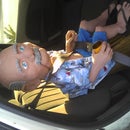Introduction: Turn a Stuffed Animal Into a Vent Puppet!
The future Dr Owl, the Wise! ... He's going to be a slightly confused know-it-all and soothsayer. Note the mouth and eyes, cuz those are going to change!
Step 1:
...Pick your stuffed animal. I picked out several frogs at a local thrift shop, and, after explaining my purpose, got complete strangers to pick the one they would "talk to" if they actually talked to a frog. ... Open a seam and remove the stuffing that you do not want. I opened Dr. Owl's mouth seam, cuz I want his mouth to move, and and removed the stuffing in his body only, not his legs or feet. I removed his black bead eyes, replacing them with larger, more expressive green ones. ... I also made a template for his mouth. The 'V' slots are for the rubber bands that work as jaw muscles. ... To the right is a spindle off an old chair. It became the control stick.
Step 2:
Then build your control stick. ... Mine is simple and only works the mouth. ... Note the nail? IT did NOT make it into the final build. You can see its gone in the next to last picture here. With the bead 'teeth' added, I did not need it as a hinge. I DID have to sand down the back beads to get the front ones to touch. ... DO NOTE how I curved the back edge of the lower jaw to work as a hinge. THAT keeps the lower jaw from creeping out of place due to friction later. ... Finally i did a dry fit of the control stick (It 'sticks' out the butt end of the frog, as you'll see later) and to do that I had to open the rear seam a bit. ... NOTE how I built the control stick. The fixed jaw is the upper one. I had to cut a section of the stick, half way through and a half inch short of the front of the top jaw, which I glued tight to the stick. The moving jaw is the lower, like your own mouth. Three medium #30 rubber bands hold them together; and I put the slot in the back of the jaws for the rubber bands to control their tension and keep them in p[lace and hidden in the back of the mouth. ... Also NOTE the use and placement of the eye screws, one on the lower jaw and the other on the stick itself. The string runs out the back end of the frog and ties, right where it comes out, onto a ring - so I can both hold the stick and work the jaw by pulling back on the string.
Step 3:
Re-stuff the body. ... I replaces the fiber fill with foam. Because the control stick runs through the body, I drew out and cut two pieces, a top and bottom. The bottom was too thick so I cut it in half with a sharpened butcher knife. Then I used the same knife and scissors to shape each one to the round of the body. ... Note: On a dry fit I discovered the tightness of the foam prevents the mouth mechanism from working, so I had to cut a slot in the bottom foam to allow the string to freely move.
Step 4:
Here is the almost finalized shots. ... On my tests with REAL people, I was told he had an imposing set of teeth. They did not like so many. So I made the upper lip wrap over them, to hide all the top ones. That worked and he got good reviews. ... I had a bit of trouble with the yellow throat material creeping back because of the foam. I tried a cut out of mylar to stop the problem, but did not like the effect. So I took it out and just glued the lip to the jaw really well! That worked ... and I knew Dr. Owl was a complete success after the Grandson messed with him and gave him a kiss on the mouth! .... I'm sorry there's no picture of the ring mechanism, but its very simple, and you can see how it works. ... I set Dr. Owl, The Wise, on his tuffet, grab the control stick and catch the ring with my index finger, pull back on it and talk as his mouth opens. .... Again, he's Grandson approved!!!!!




